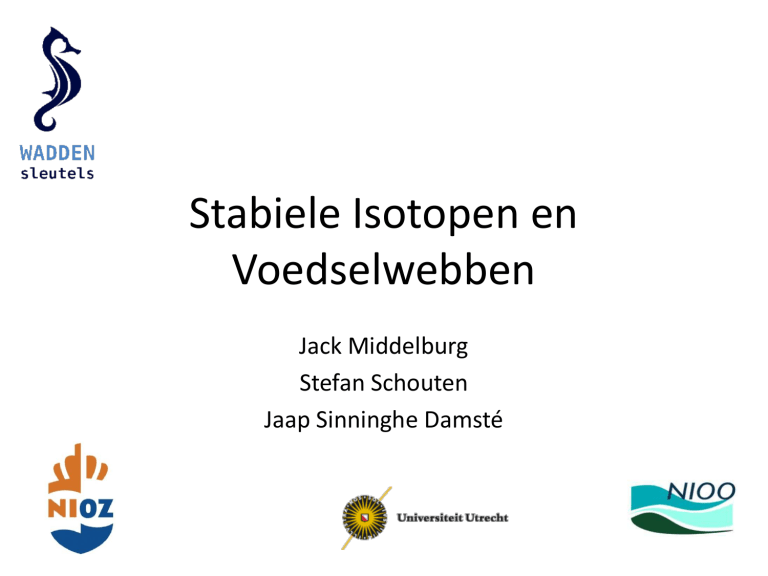
Stabiele Isotopen en
Voedselwebben
Jack Middelburg
Stefan Schouten
Jaap Sinninghe Damsté
Stabiele Isotopen:
zware en lichte
13C en 12C
15N en 14N
2H en 1H
Lichte >>> Zware
99% vs. 1%
Chemisch identiek,
maar…
Fractionatie
• Verschillen in isotoopverdelingen
door fractionatie/discriminatie tijdens
omzettingen
• Fractionatie vindt plaats als gevolg van
fysische, chemische, maar vooral biologische
processen.
• Fractionatie gebeurt vooral aan basis
voedselweb: primaire productie en
microbiologische omzettingen
Wat zijn stabiele isotopen?
d 2H
d 13C
d 15N
d 18O
d 34S
12C:
6 protons +6 neutrons
13C: 6 protons + 7 neutrons
14C: 6 protons + 8 neutrons
98.9 %
1.1 %
unstable
Hoe bepalen we stabiele koolstof isotopen?
Eerst moeten we er een gas van maken …...
44: 12C16O16O
CO2
45: 13C16O16O
+ 12C17O16O
46: 12C18O16O
Amount 13C
Basic principles continuous flow isotope mass spectrometer
mv2 / r = Hev
or
radius = (mass*velocity)/(ion charge*magnetic field strength)
Hoe bepalen we stabiele koolstof isotopen?
Absolute isotope numbers are very difficult to measure accurately
However, relative differences can be measured accurately
Isotope
Gas
d 13C
Mass
CO2
44/45/46
“Reference”
VPDB
Delta notation
(13C/12C)sample - (13C/12C)PDB
d 13Csample =
(13C/12C)
X 1000 [‰]
PDB
(13C/12C)PDB = 0.0112372
Isotope Lingo
d13C = -14‰
d13C = -21‰
d13C = -27‰
… zwaar
… verrijkt
…. zeer positief
… licht
… verarmt
…. zeer negatief
Fractionatie: Primaire Productie
• d13Cplant= d13Csubstrate-
• Fractionatie factor ():
– Rubisco enzyme: 27 ‰
– C3-plants: 20 ‰
– C4-plants: 6 ‰
•
d13Csubstrate:
– CO2atm: -8 ‰
– DICocean: + 1 ‰
Terrestrial C3 plants: -28 ‰
Terrestrial C4 plants: -14 ‰
Phytoplankton: -19 ‰
Stable carbon isotope ratios Westerschelde
Anthropogenic
and terrestrial
(-26 o/oo)
Seagrasses
(-10 o/oo)
River plankton
(-35 o/oo)
Salt marsh
macrophytes
(-13 or -26 o/oo)
Benthic algae
(-15 to -20 o/oo)
Marine plankton
(-18 to -21 o/oo)
Stabiele Isotope in Food Web
• “You are what you
eat”
– Koolstof, zwavel
• “You are what you eat
+ something”
– Stikstof
0
DIC ocean
-10
CO2 atmosphere
d13C
DIC river
-20
C4 plants
Cons.
Marine Algae
Cons.
C3 plants
Cons.
River Algae
Cons.
-30
-40
CO2 source
Consumer
Verrijking 15N per trofisch niveau
d15N: 3.4 ‰ heavier per trophic level
Trophic position =
1+ (d15Nconsumer- d 15Nbaseline)/3.4
Waarom Stabiele Isotopen?
• Voedsel:
– Tijdsgeïntegreerd beeld ipv maag inhoud
– Voedsel natuurlijke condities (ipv in kooien, etc)
– Alle heterotrofen, inclusief osmotrofen/microbes
• Foodwebs:
– Historische voedselwebben (musea)
– Snelle scan van structuur
– Integratie van alle organismen, end-to-end (E2E),
want zelfde eenheid
Theorie en Praktijk
14
Predator
Omnivore
12
15
d N
10
Voedselwebben zijn continue ipv
Predator
discreet
• meerdere bronnen
• variable isotope ratio van bronnen
Herbivore
Herbivore
• organisme leven op meer dan 1
Consumer living on
bron & omnivory
multiple primary producers
Primary Producer
Primary Producer
Real food web
8
6
4
2
-21
-19
-17
d 13C
-15
Waddenzee?
• ISI:
– Ecology: 92496 hits
– Ecology & Isotopes: 986 hits
– Wadden Sea: 2361 hits
– Wadden Sea & Isotopes: 15 hits
• Mg, S and NO3 isotopes
• Geen eén op voedselweb
Molenplaat in Zeeland
Trophic
shift
• Phytoplankton
gebaseerde secundaire
produktie: bv. kokkel
•Benthische algen
gebaseerde secundaire
produktie: b.v. wadslak
•Meeste organismen
afhankelijk van beiden
•Nepthys en Eteone
omnivore/carnivore
Phytoplankton
Benthic microalgae
Zandige site op Molenplaat
Trophic
shift
• Ook hier benthische
en pelagische algen
gevoed web
•Shift in base-line van
15N
Phytoplankton
Benthic microalgae
Carbon flow in tidal flat community
phytoplankton
detritus
filter feeding
macrobenthos
detritus
Carbon input:
Detritus deposition: 14%
Phytopl. deposition: 48 %
Suspension feeders: 6%
Benthic prim. prod.: 32%
phytobenthos
deposit feeding
macrobenthos
bacteria
Secondary production:
Bacteria:
74%
Macrofauna: 15 %
Microbenthos: 10%
Meiofauna:
2%
nematodes
meiobenthos
Van Oevelen et al. (2006)
Hoe meten we microbes en
benthisch algen
polarlipid-derived-fatty-acids
PLFA (13C, 2H)
D-Alanine (13C and 15N);
Constituent of peptidoglycan: cell
wall of bacteria (living bacteria and
their remains)
rRNA (13C)
DNA (13C)
Component Specifieke IRMS
40 carbon atoms
Elution in order of volatility ~ molecular weight
20 carbon atoms
-27.4
-20.4
-20.3
Retention time
Subtidale zanden (Sylt)
Evrard et al. 2010
Meerdere bronnen en onzekerheden vragen om
mengmodellen
Evrard et al. 2010
Ontogeny
• Macoma balthica
– Larven: phytoplankton
– Jong: microphytobenthos
– Volwassen: phytoplankton
Uitdagingen
• Relatieve belang van:
– Phytoplankton
– Benthische algen
– Allochtoon materiaal (direct of via bacteriën)
• Heterogeniteit binnen phytoplankton en
microphytobenthos gemeenschappen en
consequenties voedselweb
Uitdagingen
• Phytoplankton: lokaal geproduceerd of
geïmporteerd uit de Noordzee
• Waterstoffen isotopen in voedselweb
reconstructies:
– Noordzee vs. Waddenzee
– Waterkolom vs. sediment
Waarom?
• Waddenzee wisselt uit met Noordzee en
ecosysteem budget laten zien dat er netto
organisch materiaal geïmporteerd wordt.
• Benthische algen productie is vergelijkbaar
met phytoplankton productie: zeer weinig
kennis.
• Microbes zijn de link tussen element fluxen en
voedselweb.
